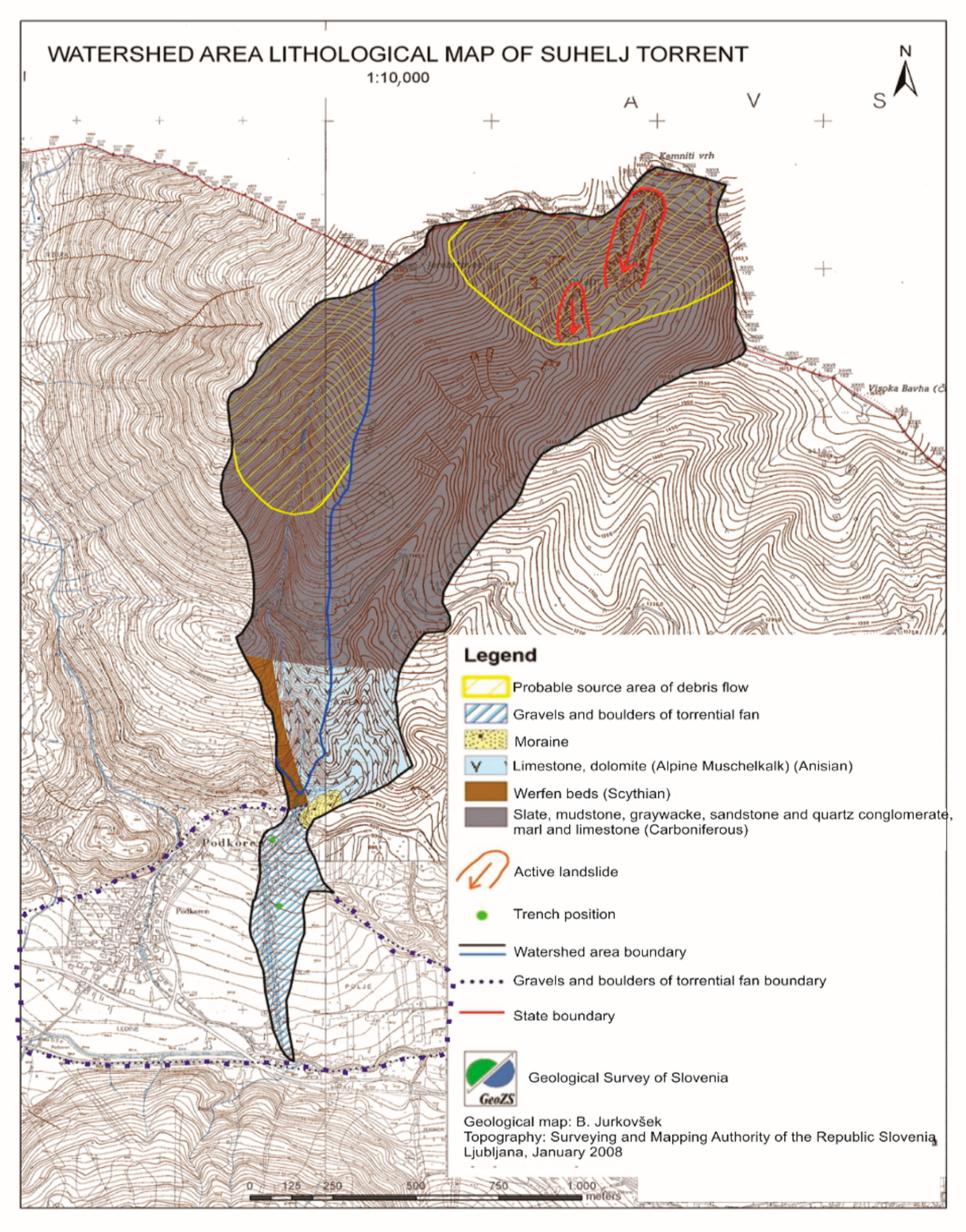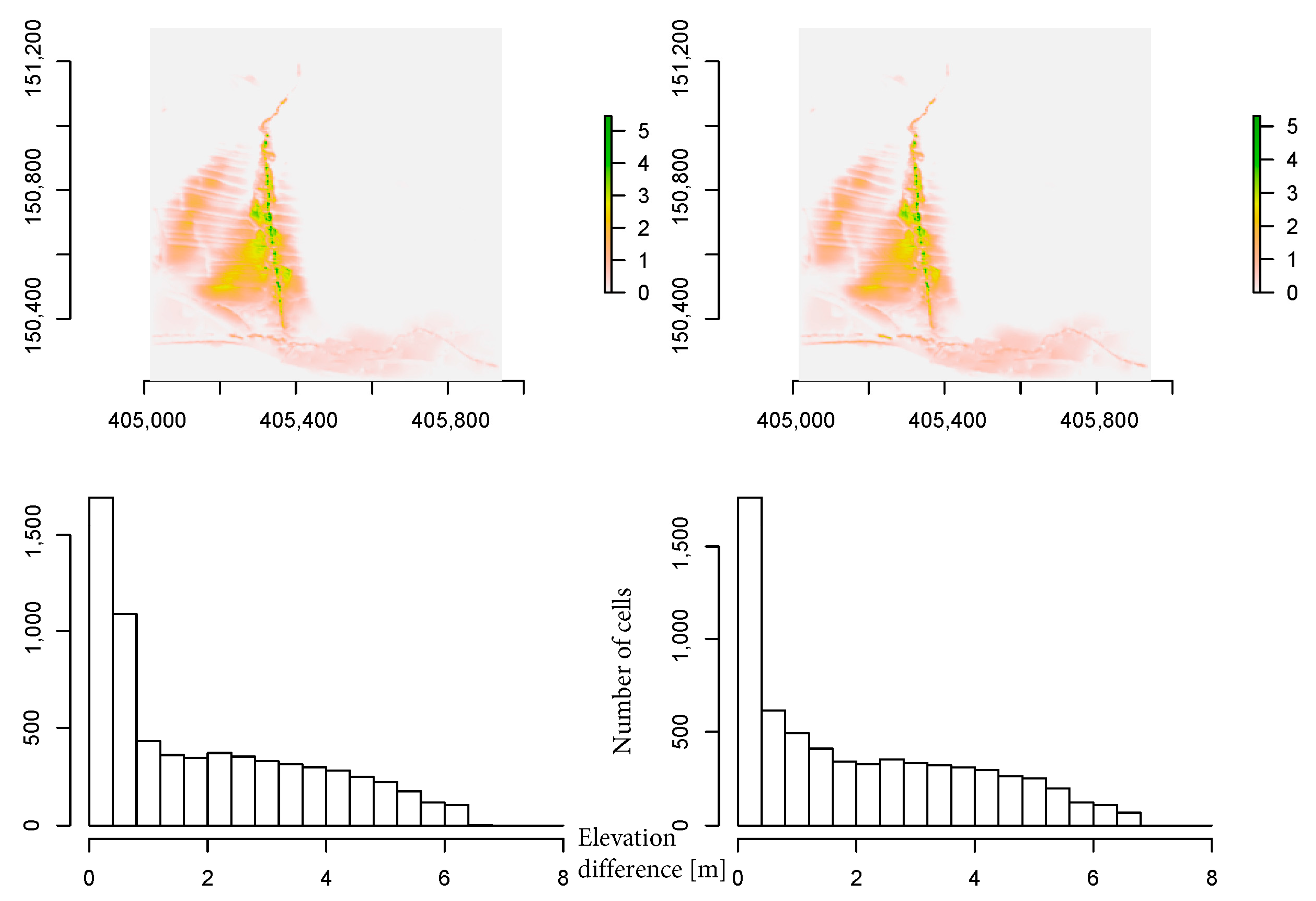Impact of a Random Sequence of Debris Flows on Torrential Fan Formation
Abstract
:1. Introduction
2. Data and Methods
2.1. RAMMS Software
2.2. The Suhelj Torrential Fan
2.3. Artificial Terrain
2.4. Debris-Flow Magnitudes and RAMMS-DF Parameters
2.5. Statistical t-Test and Mann–Whitney (MW) Test
3. Results and Discussion
3.1. Suhelj Fan
3.2. Artificial Terrain
4. Conclusions
Author Contributions
Funding
Conflicts of Interest
References
- Varnes, D.J. Landslide types and processes. In Landslides and Engineering Practice; Special Report 28; Eckel, E.B., Ed.; Highway Research Board, National Academy of Sciences: Washington, DC, USA, 1954; pp. 20–47. [Google Scholar]
- Varnes, D.J. Slope movement types and processes. In Landslides, Analysis and Control; Special Report 176; Schuster, R.L., Krizek, R.J., Eds.; Transportation Research Board. National Academy of Sciences: Washington, DC, USA, 1978; pp. 11–33. [Google Scholar]
- Hungr, O.; Leroueil, S.; Picarelli, L. The Varnes classification of landslide types, an update. Landslides 2015, 11, 167–194. [Google Scholar] [CrossRef]
- Jakob, M. Debris-flow hazard analysis. In Debris-Flow Hazards and Related Phenomena; Praxis; Jakob, M., Hungr, O., Eds.; Springer: Berlin/Heidelberg, Germany, 2005; pp. 411–443. [Google Scholar]
- Stoffel, M.; Bollschweiler, M.; Butler, D.R.; Luckman, B.H. (Eds.) Tree Rings and Natural Hazards—A State-of-the-Art; Springer Science+Business Media B.V: Dordrecht, The Netherlands, 2010; p. 505. [Google Scholar]
- Schneuwly-Bollschweiler, M.; Stoffel, M.; Rudolf-Miklau, F. (Eds.) Dating Torrential Processes on Fans and Cones—Methods and Their Application for Hazard and Risk Assessment; Springer Science+Business Media: Dordrecht, The Netherlands, 2013; p. 423. [Google Scholar]
- Rickenmann, D. Runout prediction methods. In Debris-Flow Hazards and Related Phenomena; Praxis; Jakob, M., Hungr, O., Eds.; Springer: Berlin/Heidelberg, Germany, 2005; pp. 305–324. [Google Scholar]
- Stancanelli, L.M.; Peres, D.J.; Cancelliere, A.; Foti, E. A combined triggering-propagation modeling approach for the assessment of rainfall induced debris flow susceptibility. J. Hydrol. 2017, 550, 130–143. [Google Scholar] [CrossRef]
- Christen, M.; Bühler, Y.; Bartelt, P.; Leine, R.; Glover, J.; Schweizer, A.; Graf, C.; Mc Ardell, B.W.; Gerber, W.; Deubelbeiss, Y.; et al. Integral hazard management using a unified software environment: Numerical simulation tool “RAMMS” for gravitational natural hazards. In Proceedings of the 12th Congress INTERPRAEVENT, Grenoble, France, 23–26 April 2012; Koboltschnig, G., Hübl, J., Braun, J., Eds.; pp. 77–86. [Google Scholar]
- Frank, F.; Mc Ardell, B.W.; Huggel, V.; Vieli, A. The importance of entrainment and bulking on debris flow runout modeling: Examples from the Swiss Alps. Nat. Hazards Earth Syst. Sci. 2015, 15, 2569–2583. [Google Scholar] [CrossRef]
- von Fischer, F.; Keiler, M.; Zimmermann, M. Modelling of individual debris flows using Flow-R: A case study in four Swiss torrents. In Proceedings of the INTERPRAEVENT 2016 Conference, Lucerne, Switzerland, 30 May–2 June 2016; pp. 257–264. Available online: http://www.interpraevent.at/palm-cms/upload_files/Publikationen/Tagungsbeitraege/2016_1_257.pdf (accessed on 22 January 2019).
- Frank, F.; Mc Ardell, B.W.; Oggier, N.; Baer, P.; Christen, M.; Vieli, A. Debris-flow modeling at Meretschibach and Bondasca catchments, Switzerland: Sensitivity testing of field-data-based entrainment model. Nat. Hazards Earth Syst. Sci. 2017, 17, 801–815. [Google Scholar] [CrossRef]
- Schraml, K.; Thomschitz, B.; McArdell, B.; Graf, C.; Kaitna, R. Modeling debris-flow runout patterns on two alpine fans with different dynamic simulation models. Nat. Hazards Earth Syst. Sci. 2015, 15, 1397–1425. [Google Scholar] [CrossRef]
- Vennari, C.; Mc Ardell, B.; Parise, M.; Santangelo, N.; Santo, A. Implementation of the RAMMS DEBRIS FLOW to Italian case studies. Geophys. Res. Abstr. 2016, 18, EGU2016-11378. [Google Scholar]
- Hussin, H.Y. Probabilsitic Run-out Modeling of a Debris Flow in Barcelonnette, France. Master’s Thesis, University of Twente, Enschede, The Netherlands, 2011; p. 94. Available online: https://webapps.itc.utwente.nl/librarywww/papers_2011/msc/aes/hussin.pdf (accessed on 22 January 2019).
- Hussin, H.Y.; Quan Luna, B.; van Westen, C.J.; Christen, M.; Malet, J.-P.; van Asch, T.W.J. Parameterization of a numerical 2-D debris flow model with entrainment: A case study of the Faucon catchment, Southern French Alps. Nat. Hazards Earth Syst. Sci. 2012, 12, 3075–3090. [Google Scholar] [CrossRef]
- Sherchan, B. Entrainment of Bed Sediments by Debris Flow. Master’s Thesis, Department of Civil and Transport Engineering, Norwegian University of Science and Technology, Trondheim, Norway, June 2016; p. 116. Available online: https://brage.bibsys.no/xmlui/bitstream/handle/11250/2416456/15278_FULLTEXT.pdf (accessed on 22 January 2019).
- RAMMS. User Manual v1.7.0 Debris Flow. 2018. Available online: http://ramms.slf.ch/ramms/downloads/RAMMS_DBF_Manual.pdf (accessed on 22 January 2019).
- Christen, M.; Kowalski, J.; Bartelt, P. RAMMS: Numerical simulation of dense snow avalanches in three-dimensional terrain. Cold Reg. Sci. Technol. 2010, 63, 1–14. [Google Scholar] [CrossRef] [Green Version]
- Christen, M.; Gerber, W.; Graf, C.; Bühler, Y.; Bartelt, P.; Glover, J.; Mc Ardell, B.; Feistl, T.; Steinkogler, W. Numerische Simulation von gravitativen Naturgefahren mit “RAMMS” (Rapid Mass Movements). Zeitschrift für Wildbach Lawinen Erosions und Steinschlagschutz 2012, 169, 282–293. [Google Scholar]
- Simoni, A.; Mammoliti, M.; Graf, C. Performance of 2D debris flow simulation model RAMMS. Back-analysis of field events in Italian Alps. In Proceedings of the Annual International Conference on Geological and Earth Sciences GEOS 2012, Singapore, 3–4 December 2012; p. 6. [Google Scholar]
- Grêt-Regamey, A.; Brunner, S.H.; Altwegg, J.; Christen, M.; Bebi, P. Integrating expert knowledge into mapping ecosystem services trade-offs for sustainable forest management. Ecol. Soc. 2013, 18, 34. [Google Scholar] [CrossRef]
- Hohermuth, B.; Graf, C. Einsatz numerischer Murgangsimulationen am Beispiel des integralen Schutzkonzepts Plattenbach Vitznau. Wasser Energ. Luft 2014, 106, 285–290. [Google Scholar]
- Mohorič, N.; Grigillo, D.; Jemec Auflič, M.; Mikoš, M.; Celarc, B. Longitudinal profiles of torrential channels in the Western Karavanke mountains. Geologija 2016, 59, 273–286. [Google Scholar] [CrossRef]
- UL FGG & GeoZS. Debris Flow Risk Assessment—Final Report; Faculty of Civil and Geodetic Engineering of the University of Ljubljana (UL FGG) & Geological Survey of Slovenia (GeoZS): Ljubljana, Slovenia, 2008; 224p, Available online: http://www.sos112.si/slo/tdocs/naloga_76.pdf (accessed on 22 January 2019). (In Slovenian)
- Sodnik, J.; Mikoš, M. Estimation of magnitudes of debris flows in selected torrential watersheds in Slovenia. Acta Geographica Slovenica 2006, 46, 93–123. [Google Scholar] [CrossRef] [Green Version]
- Stoffel, M. Magnitude–frequency relationships of debris flows—A case study based on field surveys and tree-ring records. Geomorphology 2010, 116, 67–76. [Google Scholar] [CrossRef]
- Johnson, P.A.; McCuen, R.H.; Hromadka, T.V. Magnitude and frequency of debris flows. J. Hydrol. 1991, 123, 69–82. [Google Scholar] [CrossRef]
- Cesca, M.; D’Agostino, V. Comparison between FLO-2D in RAMMS in debris-flow modelling: A case study in the Dolomites. WIT Trans. Eng. Sci. 2008, 60, 197–206. [Google Scholar]
- Scheuner, T.; Schwab, S.; McArdell, B. Appplication of a two-dimensional numerical model in risk and hazard assessment in Switzerland. In Proceedings of the 5th International Conference on Debris-Flow Hazards Mitigation: Mechanics, Prediction and Assessment, Padua, Italy, 14–17 June 2011. [Google Scholar]
- Quan Luna, B.; Cepeda, J.; Stumpf, S.; van Westen, C.J.; Remaitre, A.; Malet, J.P.; van Asch, T.W.J. Analysis and Uncertainty Quantification of Dynamic Run-Out Model Parameters for Landslides. In Landslide Science and Practice; Margottini, C., Canuti, P., Sassa, K., Eds.; Springer: Berlin/Heidelberg, Germany, 2013. [Google Scholar]
- Bezak, N.; Rusjan, S.; Petan, S.; Sodnik, J.; Mikoš, M. Estimation of soil loss by the WATEM/SEDEM model using an automatic parameter estimation procedure. Environ. Earth Sci. 2015, 74, 5245–5261. [Google Scholar] [CrossRef]
- Fagerland, M.W.; Sandvik, L. The Wilcoxon–Mann–Whitney test under scrutiny. Stat. Med. 2009, 28, 1487–1497. [Google Scholar] [CrossRef] [PubMed]
- R Software. Student’s t-Test. 2018. Available online: https://www.statmethods.net/stats/ttest.html (accessed on 22 January 2019).
- R Software. Wilcox Test. 2018. Available online: https://stat.ethz.ch/R-manual/R-devel/library/stats/html/wilcox.test.html (accessed on 22 January 2019).










| Voellmy Parameters | Case Number |
|---|---|
| µ = 0.1, ξ = 100 ms−2 | 1 |
| µ = 0.1, ξ = 1500 ms−2 | 2 |
| µ = 0.2, ξ = 150 ms−2 | 3 |
| µ = 0.2, ξ = 600 ms−2 | 4 |
| µ = 0.4, ξ = 100 ms−2 | 5 |
| µ = 0.4, ξ = 400 ms−2 | 6 |
| µ = 0.4, ξ = 1500 ms−2 | 7 |
| µ = 0.5, ξ = 400 ms−2 | 8 |
| Case | Average Fan Height [m] | Maximum Fan Height [m] | Fan Area [ha] | Average Fan Height [m] | Maximum Fan Height [m] | Fan Area [ha] | t-test p-Value | MW test p-Value |
|---|---|---|---|---|---|---|---|---|
| 1 | 0.60 | 5.45 | 31.4 | 0.56 | 5.31 | 30.4 | 0.90 | 0.89 |
| 2 | 0.64 | 5.24 | 23.3 | 0.69 | 5.46 | 27.4 | 0.35 | 0.62 |
| 3 | 0.77 | 7.83 | 23.2 | 0.61 | 7.69 | 31.9 | 0.95 | 0.98 |
| 4 | 0.64 | 8.99 | 28.0 | 0.58 | 9.04 | 33.5 | 0.96 | 0.93 |
| 5 | 0.68 | 8.22 | 28.9 | 0.69 | 8.18 | 30.2 | 0.83 | 0.84 |
| 6 | 0.68 | 8.90 | 28.5 | 0.70 | 8.96 | 29.4 | 0.96 | 0.86 |
| 7 | 0.71 | 8.75 | 22.4 | 0.72 | 8.82 | 28.3 | 0.94 | 0.96 |
| 8 | 0.62 | 8.44 | 31.4 | 0.75 | 8.62 | 28.0 | 0.95 | 0.93 |
| Case | Average Fan Height [m] | Maximum Fan Height [m] | Fan Area [ha] | Average Fan Height [m] | Maximum Fan Height [m] | Fan Area [ha] | t-test p-value | MW test p-Value |
|---|---|---|---|---|---|---|---|---|
| 1 | 1.94 | 6.41 | 10.8 | 2.10 | 6.70 | 10.5 | 0.86 | 0.97 |
| 2 | 2.09 | 6.12 | 10.0 | 2.03 | 6.06 | 10.9 | 0.97 | 0.95 |
| 3 | 3.17 | 11.96 | 6.6 | 3.74 | 12.23 | 5.8 | 0.84 | 0.87 |
| 4 | 3.56 | 13.26 | 6.2 | 3.91 | 13.96 | 5.6 | 0.78 | 0.96 |
| 5 | 3.68 | 13.97 | 5.7 | 3.63 | 14.45 | 6.0 | 0.55 | 0.94 |
| 6 | 4.31 | 14.88 | 5.1 | 3.53 | 14.57 | 6.2 | 0.77 | 0.91 |
| 7 | 4.22 | 14.55 | 5.2 | 4.07 | 14.14 | 5.4 | 0.75 | 0.89 |
| 8 | 4.47 | 15.24 | 4.7 | 4.96 | 15.85 | 4.4 | 0.38 | 0.91 |
© 2019 by the authors. Licensee MDPI, Basel, Switzerland. This article is an open access article distributed under the terms and conditions of the Creative Commons Attribution (CC BY) license (http://creativecommons.org/licenses/by/4.0/).
Share and Cite
Bezak, N.; Sodnik, J.; Mikoš, M. Impact of a Random Sequence of Debris Flows on Torrential Fan Formation. Geosciences 2019, 9, 64. https://doi.org/10.3390/geosciences9020064
Bezak N, Sodnik J, Mikoš M. Impact of a Random Sequence of Debris Flows on Torrential Fan Formation. Geosciences. 2019; 9(2):64. https://doi.org/10.3390/geosciences9020064
Chicago/Turabian StyleBezak, Nejc, Jošt Sodnik, and Matjaž Mikoš. 2019. "Impact of a Random Sequence of Debris Flows on Torrential Fan Formation" Geosciences 9, no. 2: 64. https://doi.org/10.3390/geosciences9020064






